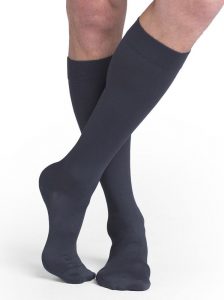If you have large legs, finding compression stockings that fit can be a challenge. For people with wide calves, whether its chronic swelling or genetic, rolling and sliding socks is often a problem. There are solutions for both of these issues. To find the absolute BEST fit, you do need to measure your leg - so take a look at our measuring guide as you get started.
Large or Thick Legs
Most manufacturers make wide-calf styles designed for customers with wide or plus size legs.
Therafirm Core-Spun products are our top pick for larger legs! Let me tell you all the ways they're amazing - they're super soft, easy to get on and come in every compression level. They even have fashionable patterns! Core-Spun Knee High Socks are available for men and women. The largest size will accommodate a 17 inch ankle with up to a 25.5 inch calf. Core-Spun Thigh Highs are available in sizes up to XXXL. They will fit an ankle up to 19″ in circumference, and a thigh up to 39.5″. Core-Spun Thigh Highs are designed for men and women, come in three compression levels and two colors: black and white. Sizes XL-XXXL are offered in the 15-20 and 20-30 mmHg compressions only. You can see where you’d fit on the size chart below:

The largest knee high and thigh high available is in the Sigvaris Secure Line. The calf sizing goes up to 74 cm (slightly over 29″) and the max thigh is 102 cm (about 40″). The Secure products are made to manage strong edema – swelling that does not do well in thinner fabrics like sheer or microfiber. While the fabric is incredibly strong, it is still breathable and comfortable to wear. With its precise sizing, you are guaranteed to get a perfect fit in this product. Available in 20-30, 30-40 and 40-50 mmHg.
The Sigvaris Comfort PLUS is another great option – it’s softer and stretchier than the Secure line. It comes in 20-30 mmHg and 30-40 mmHg. The X-Large size in this product can fit a calf up to 28″ around and they come in short and long lengths.
If you're looking for something that's more affordable in price, the Allegro Surgical Weight Knee Highs 20-30mmHg are available in Wide-Calf sizes that fit a calf circumference up to 26 inches and an ankle up to 14.5 inches. The Allegro Sheer Thigh Highs are sized up to XXX-Large to fit a 13.5 inch ankle and 32 inch thigh. A customer who purchased the Surgical Weight Knee highs said, “This product fit perfectly and I have really big calves… not too tight – comfortable. Wore them all day!” The Allegro products are a great, affordable option for most customers.
Mediven has the largest selection for wide calves. Extra-Wide Calf sizes are available in Medi Plus, Medi Comfort, Mediven for Men, Medi Assure and Mediven Forte, 20-30 mmHg and higher. Medi Extra-Wide Calf varies by size, so be sure to check the size chart for the specific stocking you are interested in.
Juzo has begun carrying a line of Dynamic Max products designed for larger legs. Size V will fit an ankle up to 14 inches, a calf up to 26 inches and a thigh up to 37 inches. The Max line is available in 20-30 and 30-40 mmHg in knee highs and thigh highs.

Jobst Full-Calf sizes are designed to fit a calf circumference of 18-24 inches and an ankle up to 14 inches. These sizes are available in Jobst for Men Casual, Jobst ActiveWear, Jobst Relief, and Jobst UltraSheer in 15-20, 20-30, and 30-40 mmHg. Full-Calf sizes are available in Jobst Opaque 20-30 mmHg and higher.
Cone Shaped Legs
When I first heard this term, I thought, “Well, nearly everyone has a cone-shaped leg – the ankle is always smaller than the thigh.” But, that is not the shape we’re speaking of when it comes to socks and stockings. When you measure your legs, many people will find that their knee circumference is smaller than the widest point of the calf. In a cone-shaped leg, the measurements do not decrease at any point as you move up the leg – the calf and knee are about the same measurement.
If your leg is cone-shaped, compression knee highs have a tendency to roll or slide. A sticky, silicone top-band will typically solve this problem. Knee highs with silicone top-bands are available in 15-20, 20-30 and 30-40 mmHg.
Mediven Vitality offers all day comfort through an advanced design. Made with a lanolin blend, they control sweat while strengthening the integrity of the sock. They have also created a silicone top-band where they use sticky silicone fibers that are woven through the band. This creates a more gentle hold against the skin.
Looking for wide-calf sheers? Try the Allegro Essential Sheers. The collection includes quality fabrics as well as a wide, comfortable top-band. The balloon toe feature also promotes comfort while wearing.
If you still have difficulty keeping the silicone top band in place, using a light adhesive at the band is a great option. It Stays is a water-soluble skin glue that is hypo-allergenic and safe for all compression stockings. It’s available in a 2 oz roll-on bottle. A dab or two of It Stays will keep your knee highs and thigh highs up all day.
If you suffer from compression that falls down or is too tight, use the above links to find relief in compression that fits. Keep in mind each brand and style varies in size, so be sure to refer to the size chart on the product page, before purchasing. If you have a question about compression sizes, or anything compression related, comment below.
]]>







